ABOUT US
Company Progress
To show the progress of our company,
we are introducing the history of the tunnel excavation business of three companies:
IHI Technology (IHI), JFE Engineering Corporation (JFE), and Mitsubishi Heavy Industries, Ltd (MHI).
-
- 1939
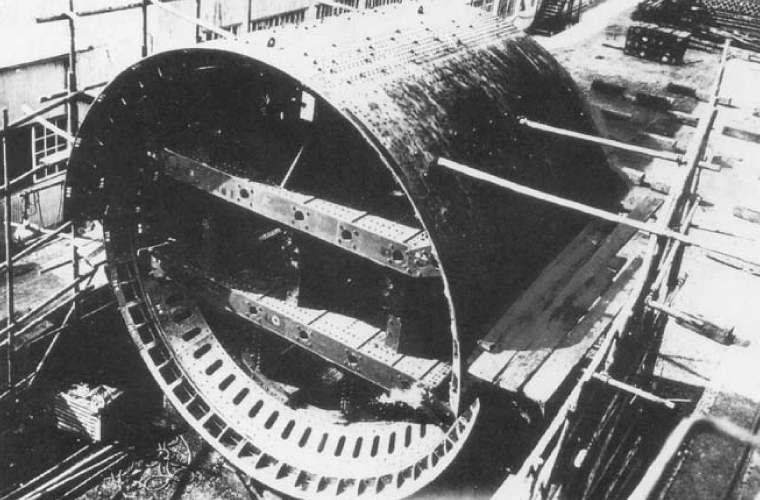
-
- DATE:
- April 1939
- TITLE:
- Japan’s First Basic Shield Machine
- PROJECT:
- Kannon Roadway Tunnel
- SIZE:
- φ7.18m
- The Mitsubishi Heavy Industries (MFI) prototype was the shield machine that was used in the Kannon Roadway Tunnel. It is a hand-operated excavator shield machine with an outer diameter of 7.18 m, and was manufactured in 1939. The structure of the main unit is assembled with rivets and bolts, and it was equipped with a hydraulic cylinder. With the top and bottom lines combined, the construction was 1.2 km. It become the model for the pneumatic method and hand-operated excavators using chemical injection that came after. In this way, the initial stage of shield machines was only hand-operated excavators. They used human operation for excavation, and the stability of the face was achieved through compressed air.
-
- 1960
-
IHI Corporation
(Formerly Ishikawajima-Harima Heavy Industries Co., Ltd.)Prototype shield machine
φ6.58 m Kakuozan, Nagaoya City
- 1967
-
JFE Engineering Corporation
(Formerly Nippon Koukan Co., Ltd.)Prototype shield machine
φ5 m Tsurumigawa River, Yokohama City
-
- 1970

-
- DATE:
- April 1970
- TITLE:
- Japan’s First Large Slurry Type Shield Machine
- PROJECT:
- Across the Morigasaki Canal of the Tokaido freight line
- SIZE:
- φ7.29m
- The actual start of the manufacture of shield machines was in 1964. These included a dredging type shield machine having a outer diameter of 7.29 m, which was used to dig the Keiyo Line Railway Tunnel under the Haneda Canal in 1970, as well as slurry shield machines thereafter. Slurry shield machines became popular in the late 1970s, which initiated the creation of large slurry shield machines which have continued until now.
-
- 1974
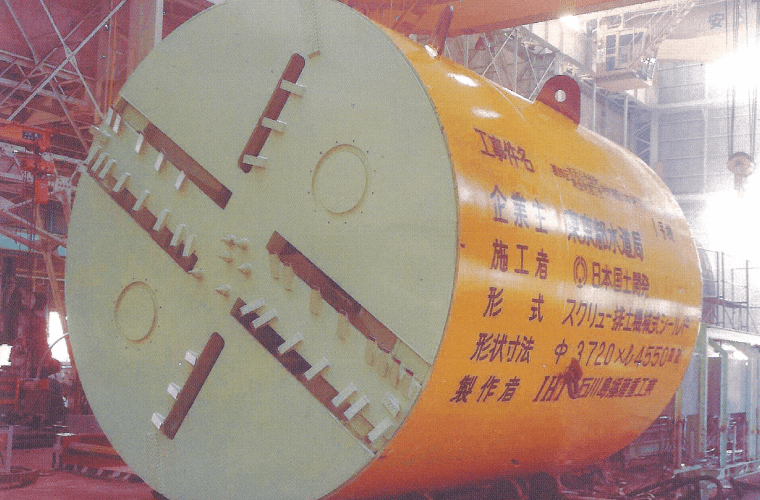
-
- DATE:
- March 1974
- TITLE:
- Japan’s First Earth Load Type Shield Machine
- PROJECT:
- Tokyo, Katsushika Ward, Mizumotokoaishinmachi-kai/4 Chome Kanamachi Sight
- SIZE:
- φ3.72m
- This was the first earth load type developed in the world. This is a common type of closed type shield machine, and it makes use of the force in excavating tunnels in soft ground as well as in various other types of subsoil, from the gravel layer to sand gravel layer. One characteristic of this earth load type is that it does not require large equipment on the surface, so it is often used for work in narrow places or urban areas. It can work with small bore diameters to large bore diameters in excess of φ16 m, so it is currently the mainstay type of machine in the industry.
-
- 1986
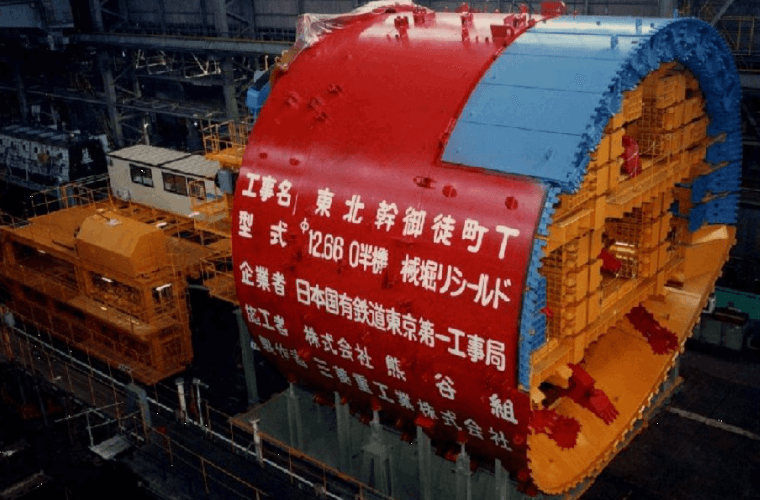
-
- DATE:
- October 1986
- TITLE:
- Ultra Large Half Mechanical Type Shield Machine
- PROJECT:
- Construction of JR Tohoku Shinkansen
- SIZE:
- φ12.66m
- Constructed was performed on the Tohoku Shinkansen Okachimachi Tunnel, which was created in 1986. The bore diameter is 12.66 m. The shield is equipped with automatic assembly equipment of the pin pivot segment. This shield predicted the development of automation that we see today.
-
- 1987
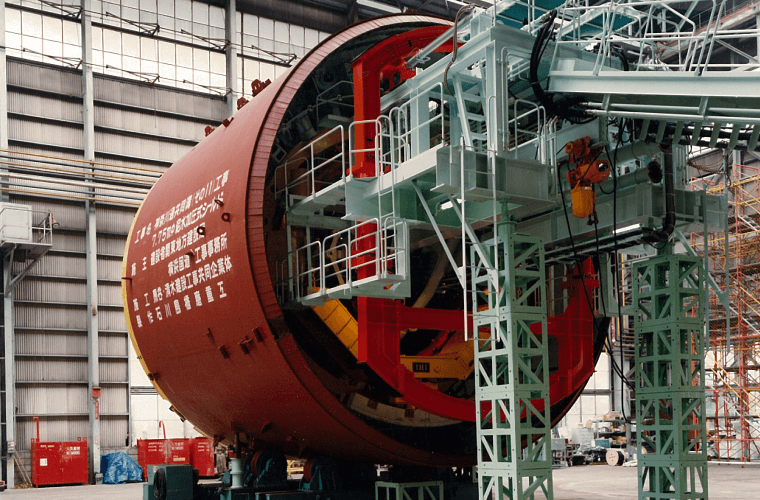
-
- DATE:
- January 1987
- TITLE:
- The World’s First Segment Automatic Assembly Erector Equipment
- PROJECT:
- Ministry of Construction, Kanagawa Utility Tunnel
- SIZE:
- φ7.75 m slurry shield machine
- The year 1987 saw the world’s first equipping of a prototype of a segment assembly automatic robot in a φ7.75 m slurry shield machine. This robot was indispensable for the wide-range automation in shield construction. This robot safely and accurately performs automation of tasks involved in the assembly of segments, from delivery of the segment to the positioning and fastening of bolts. Assembly was automatically completed smoothly for a segment having a length of 700 m, including the curve parts, and it received high appraise.
-
- 1989
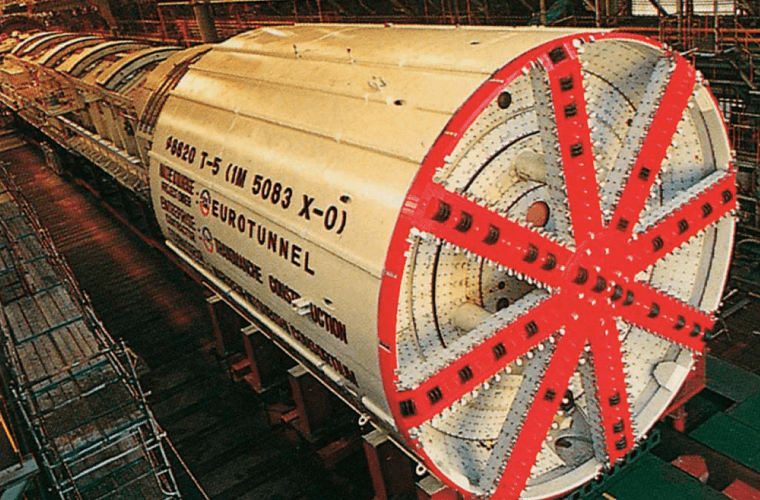
-
- DATE:
- April 1989
- TITLE:
- English Channel (T-4)
- SIZE:
- φ5.59 m earth load type shield machine
- DATE:
- December 1989
- TITLE:
- English Channel (T-5)
- SIZE:
- φ8.62 m earth load type shield machine
- This is a shield machine that was used in a global project, the English Channel Tunnel. In 1989, shield machines for the service tunnel and main pit, one of each in the sizes of φ5.59 m and φ8.62 m, were manufactured and delivered. The soil was of excellent quality, but, despite being an earth load type shield machine, it achieved a maximum of 900 m a month, which became the blueprint for high-speed construction shield machines. The main tunnel has a round trip of 3.2 km, which 6.4 km of construction being performed.
-
- 1991

-
- DATE:
- January 1991
- TITLE:
- Ultra Large Horseshoe-shaped Shield Machines
- PROJECT:
- Construction of Hokuriku Shinkansen Akima Tunnel
- SIZE:
- H9.92m×W10.7m(ECL)
- This is a horseshoe-shaped ECL (cast-in-place lining) shield machine that was produced in the year 1991. It was used for construction of the Hokuriku Shinkansen Akima Tunnel (H: 9.92 m x W: 10.7 m). The rear part of the main unit is constructed with molding assembly equipment. It can inject concrete between the molding and the ground for direct injection concrete pouring. This is the second device to use technology imported from Germany (the first being a machine of φ8.4 m for the second water channel of Shinanogawa Power Station in 1987). This ECL technology successfully created an integration with the φ6.6 m slurry shield machine used in Okayama (Okanami Kyodo Mine) in 1995.
-
- 1992
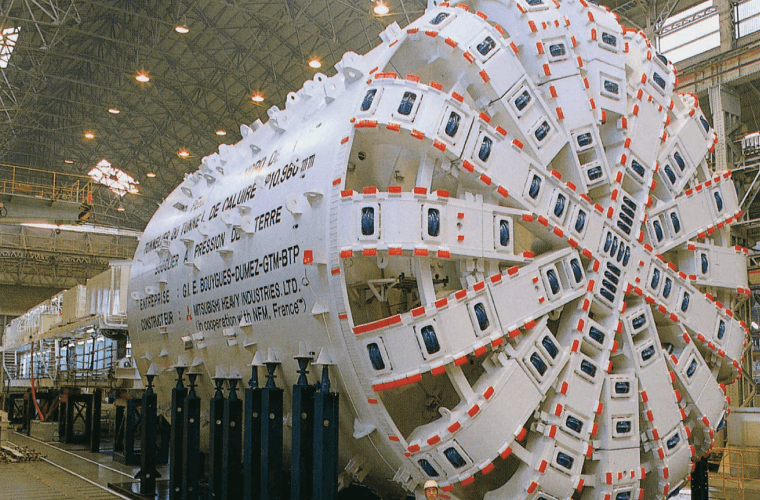
-
- DATE:
- July 1992
- TITLE:
- Large Overseas Composite Ground Project
- PROJECT:
- Lyon High Speed Traffic Tunnel
- SIZE:
- φ10.96 m earth pressure balanced shield machine
- This is a shield machine that was used for a traffic tunnel in Lyon, France. It is a large shield machine, with an outer diameter of φ10.96 m, and it was produced in 1992. It includes both the functions of Rock TBM and an earth load type shield machine. Excavation was a round trip over a distance of 3.2 km of bedrock and alluvium subsoil, with construction performed over 6.4 km.
-
- 1994

-
- DATE:
- February 1994
- TITLE:
- The World’s Largest Slurry Shield Machine (At the Time)
- PROJECT:
- Construction of Tokyo Bay Expressway (Aqua-Line) Tunnel
- SIZE:
- φ14.14 m shield machines x 4
- These are shield machines for the Tokyo Bay Expressway (Aqua-Line), and they were produced in 1994. Four shield machines with an outer diameter of 14.14 m were produced and delivered. With over 10 years of investigation, these were the world’s largest shield machines at the time.They incorporated some of the latest technologies at the time, such as support for high water pressure, long-distance excavation, and segment automatic assembly technology.
-
- 1994

-
- DATE:
- June 1994
- TITLE:
- Horn Method
Criss-cross Successive Shield Machine - PROJECT:
- Near Tokyo Adachi Ward, Hanahata 7/8 Chome
- SIZE:
- φ5.82m×φ2.89m
- This is the world’s first criss-cross successive boring machine, which uses the horn method, which allows a single shield machine to successively excavate both the vertical and horizontal shafts from the surface. It also incorporated a vertical shaft excavation function using caissons or diaphragm walls, which were required in conventional construction methods. This made it possible to make the vertical shaft area more narrow, thereby contributing to shorter construction periods and reduced costs.
-
- 1995
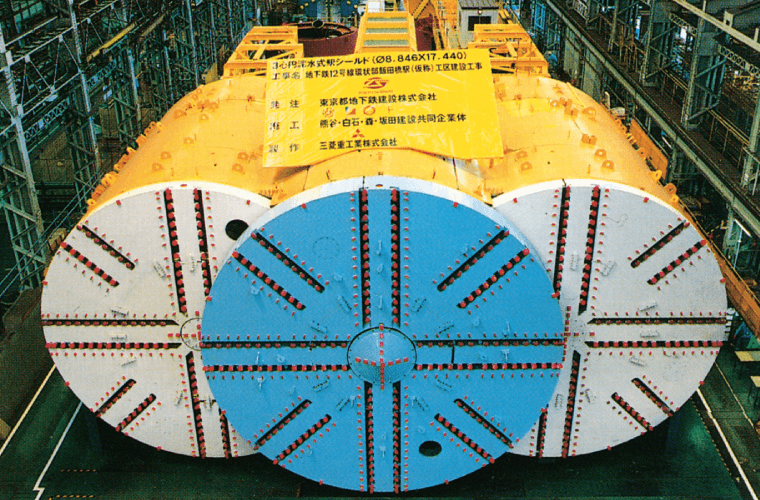
-
- DATE:
- July 1995
- TITLE:
- Three Concentric Circles (MF) Slurry Type
- PROJECT:
- Construction for Metropolitan Subway Line 12 Loop Iidabashi Station
- SIZE:
- φ8.84 m × φ17.44 m shield machines
- This shield machine, completed in 1995, has a width of more than 17 m (φ8.84 m x 17.44 m). This machine was used for construction of the Island Home Station with the track area at the same time. This machine was used for the construction of the current Iidabashi Station of the Toei Oedo Line, and the construction length was 275 m. The machine is a slurry type, adopted a multi-face structure with three concentric circles. Additionally, this machine was equipped with a articulation function that allows it to perform 125 mR construction. The machine is 17 m, and it adopted new seals. This machine was used under the special condition that the excavation of the station cannot be performed from the surface as the construction site is in the center of Tokyo.
-
- 1996
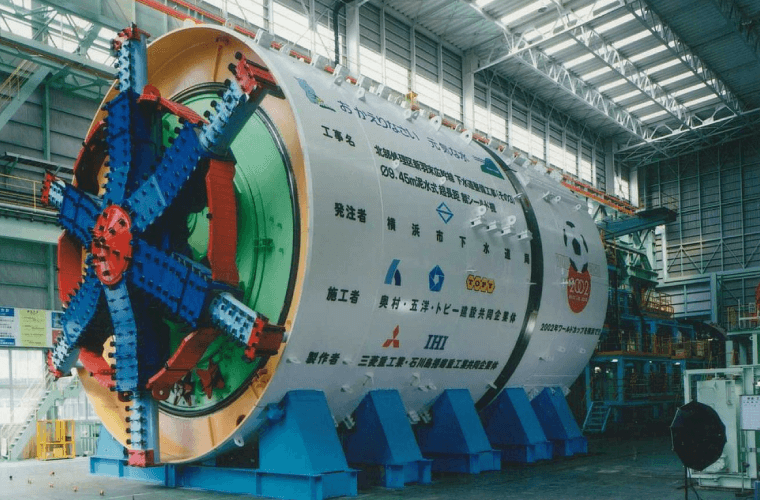
-
- DATE:
- September 1996
- TITLE:
- Sphere Type Bit Exchange Method (Croon)
- PROJECT:
- Yokohama Shin-Hanesuehiro Trunk Line
- SIZE:
- φ9.45 m slurry shield machine
- This φ9.45 m croon shield machine, produced in 1996, was used in the construction of the underwater Shin-Hanesuehiro Trunk Line in Yokohama. Its characteristics include the ability to invert the cutter head 180 degrees towards the inside of the machine, and the ability to repair and replace all cutter bits. A slurry type was adopted, with a total excavation length of 4.3 km, during which the cutter bits were replaced.
-
- 1997
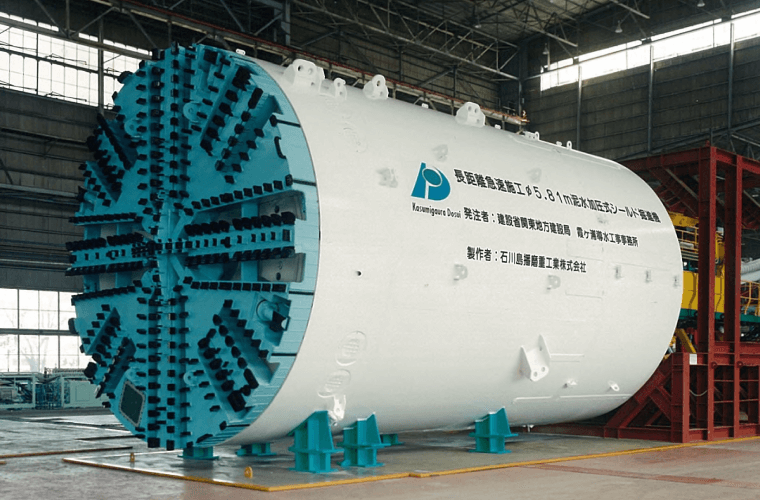
-
- DATE:
- December 1997
- TITLE:
- World’s First Fully Simultaneous Excavation with Segment Assembly
- PROJECT:
- Ministry of Construction, Kasumigauradosui Jimusho Ishioka Tunnel
- SIZE:
- φ5.81 m slurry type shield machine
- In order to achieve the initial goal of high-speed construction of 20 m a day, a space of a segment with 2 rings was assured in the tail part, and a system was adopted for simultaneous excavation, thereby allowing excavation and segment assembly to be performed at the same time. This was the first time in the industry where construction was performed with segment assembly and excavation being performed at the same time. The results were a simultaneous excavation operation rate of 91.3%, an average daily progress amount of 21.25 m, a max daily progress amount of 26.4 m, and a max monthly progress amount of 469.2 m.
-
- 1997
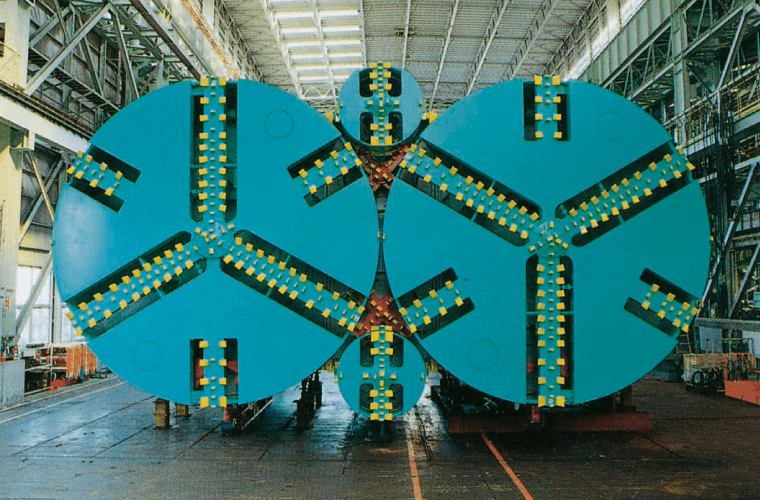
-
- TITLE:
- H&V Method Slurry Type
- PROJECT:
- Subway Line 12 Roppongi Aoyama Construction Zone
- SIZE:
- φ7.06 m × φ13.18 m shield machines
- This was the world’s largest H&V shield machine at the time. It uses two large cutters and two small cutters to perform excavation of sections required for tunnel construction. The main unit of the shield consists of three trunks, one each on the left side, right side, and center.The trunks on the left and right side are equipped with a mechanism that enables up, down, and center folding. This mechanism for up, down, and center folding deals with the rolling correction of shield machines, which was a problem with shield machines that do not have a round structure. This machine was used for the construction of the Roppongi Station in the Subway Toei Oedo Line.
-
- 1999
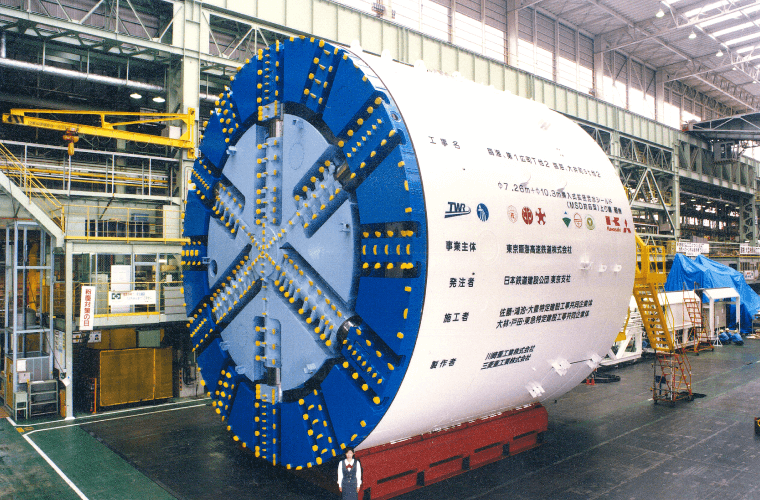
-
- DATE:
- May 1999
- TITLE:
- Insertion Type Diameter Expansion Slurry Type
- PROJECT:
- Maritime Sub-city Center HIromachi No. 1 Tunnel
- SIZE:
- φ10.3 m × φ7.26 m shield machines
- It is a φ10.3 m+7.26 m diameter expansion shield machine, and it was produced in 1999. A φ7 m child shield machine performed construction of the line. Next, construction of the station part was performed by incorporating with the parent shield machine in the vertical shaft. Normally, two shield machines are required, but this technology made it possible to reduce the costs.
-
- 2000
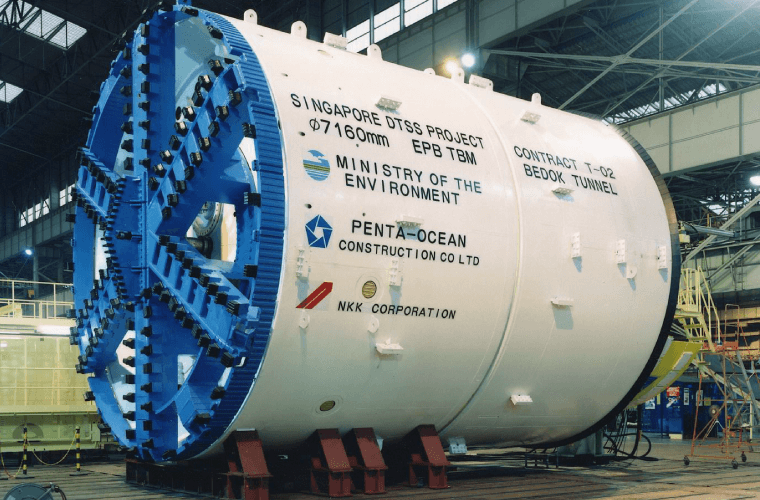
-
- DATE:
- December 2000
- TITLE:
- Deep, Long-Distance Construction Abroad
- PROJECT:
- Construction of Deep Subterranean Sewage Line in Singapore
- SIZE:
- φ7.16 m earth load shield machine
- This is a φ7.16 m mud earth load shield constructed in 2000, and it was used for a deep subterranean sewage line in Singapore. The work was the one of the world’s longest lengths, at 7.7 km. This mud earth load type machine employed a variety of technologies for increasing construction speed and for improving the structure, placement, and replacement methods of cutter bits/roller cutters. The goal was to be able to adapt to both the high-wear-resistance soil quality (old allvium) that took up the majority of the construction length and the bedrock at the destination (granaite), and to improve the resistance and work efficiency.
-
- 2003
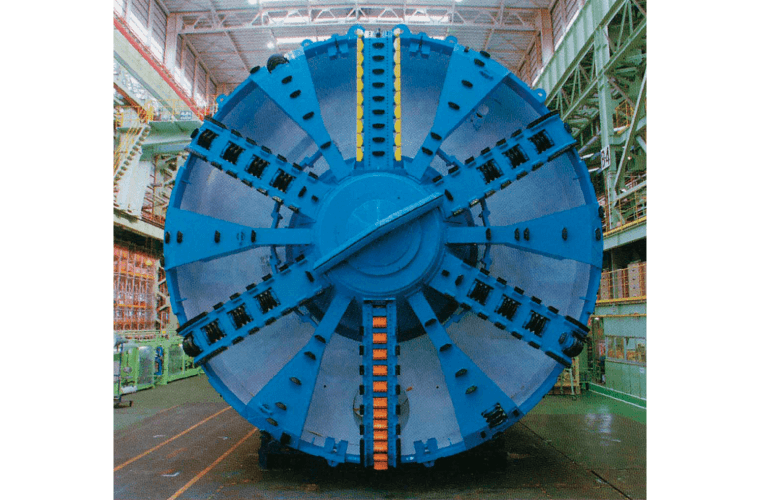
-
- DATE:
- March 2003
- TITLE:
- Trail Method
- PROJECT:
- Municipal Canal Central Trunk Line
- SIZE:
- φ7.16 m earth pressure balanced shield machine
- This is the first shield machine to adopt the trail method, which is a device for replacing cutter bits, with a medium bore size. The trail method is a method for replacing bits installed on multiple joined ring structures by retracting them into the shield machine. The machine is equipped with teeth bits and preceding bits. Both types are replaced two times each after an excavation distance of 2.7 km through the sand gravel layer.
- 2003
-
JFE Engineering Corporation
-
- 2004
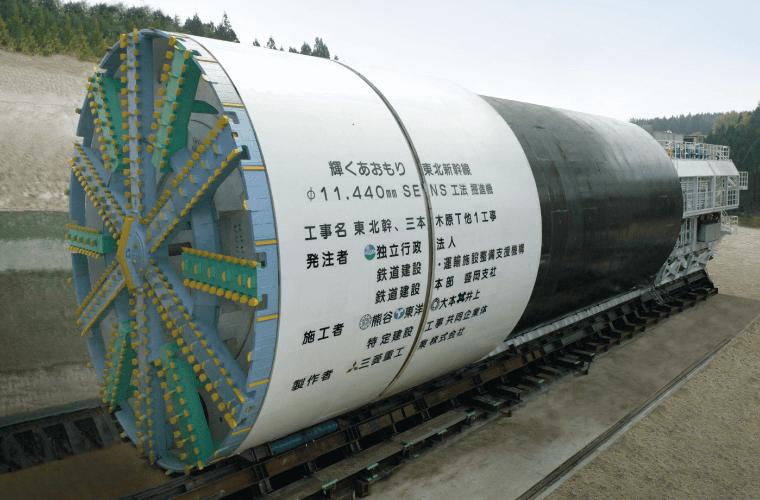
-
- DATE:
- February 2004
- TITLE:
- SENS Method
- PROJECT:
- Tohoku Shinkansen Sanbongihara Tunnel Construction Zone
- SIZE:
- φ11.44 m earth pressure balanced shield machine
- This was the first shield machine to adopt the SENS method (Shield-ECL-NATM-System). The SENS method is a tunnel construction method that involves performing excavation together with the SHELD method. In this method, concrete placement is used to construct the temporary lining while the concrete placement for the primary lining is performed in the same manner as NATM sprayed concrete. It was delivered for the Tohoku Shinkansen Sanbongihara Tunnel, which had initially been excavated using the NATM method.This machine performed excavation of 3 km through the stratum, sandy soil, layer, and cohesive soil layer in the area.
-
- 2005
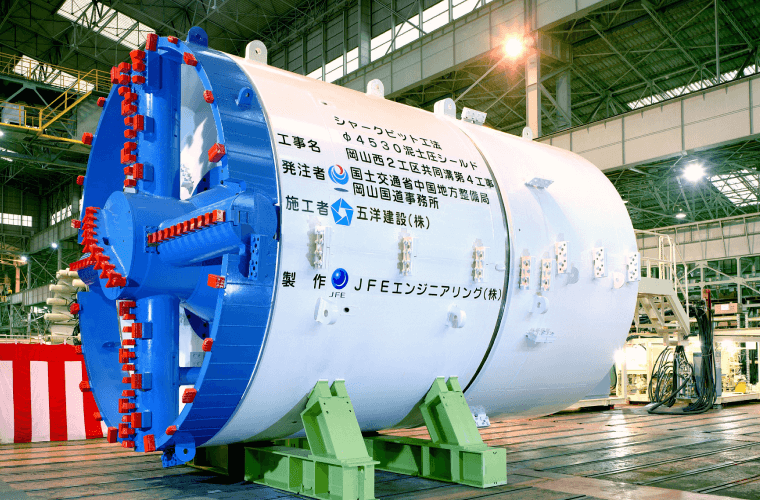
-
- DATE:
- June 2005
- TITLE:
- Shark Bit Method
- PROJECT:
- Ministry of Construction, Okayama-nishi 2 Construction Zone Utility Tunnel
- SIZE:
- φ4.53 m earth pressure balanced shield machine
- This is a φ4.53 m earth pressure balanced shield machine for shark bit method, and it was produced in 2005. It was used in the Ministry of Construction, Okayama-nishi 2 Construction Zone Utility Tunnel. The shark bit method is a replacement technology that enables replacement (restoration) of cutter bits any time, any where, and any amount of times, like shark teeth. It was used to replace the cutter bits during this construction work.
-
- 2006
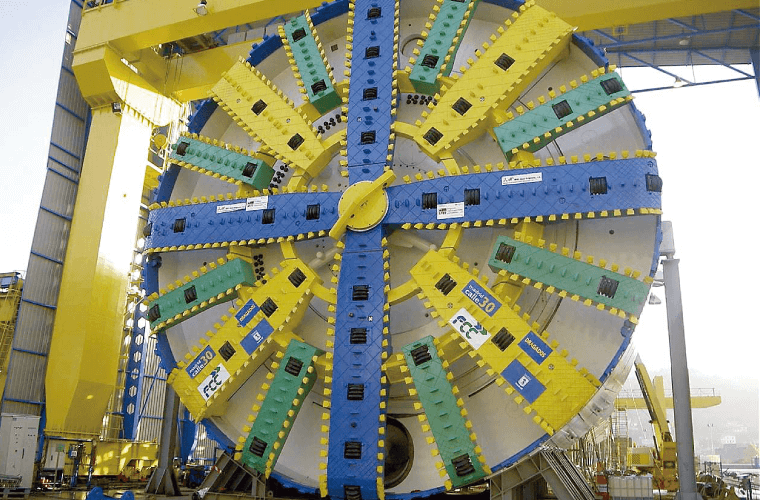
-
- DATE:
- April 2006
- TITLE:
- World’s Largest Earth Pressure Balanced Shield Machine (At the Time)
- PROJECT:
- Spain M30 Motorway Tunnel
- SIZE:
- φ15 m earth load shield machine
- This machine was used in the underground part of the M30 Orbital Motorway in Spain’s Madrid. At the time, it was the world’s largest earth pressure balanced shield machine. It was produced as a joint concern with local Spanish company Duro Felguera. The maximum excavation progress in a day was 46 m, while the maximum in a month was 802 m. The 4 km of excavation was completed in seven months.
-
- 2007
-
Establishment of Mitsubishi Underground Construction Co., Ltd.
* A separation of the Underground Construction Business of Mitsubishi Heavy Industries (MTGT)
- 2009
-
Establishment of Mitsubishi Heavy Industries Machinery Systems, Ltd.
* Reorganized and integrated by the Mitsubishi Heavy Industries Group Companies (Absorbed MTGT) (MHI-MS)
Establishment of Japan Tunnel Systems Company
* Integrated the shield machine business of both IHI and JFEI (JTSC)
-
- 2009

-
- DATE:
- November 2009
- TITLE:
- Ultra Long-Distance Large Section High-Speed Construction
- PROJECT:
- Metropolitan Expressway Central Circular Route
- SIZE:
- φ12.53 m earth pressure balanced shield machine
- This shield machine realized high-speed construction through a simultaneous excavation system and segment semi-automatic assembly system. With a shield machine that was over φ10 m at the time, the construction was performed over one of the world’s longest excavation distances of 8 km without any changes to the bits. This shield machine achieved an average monthly progress of 434 m and a maximum monthly progress of 637 m.
-
- 2009
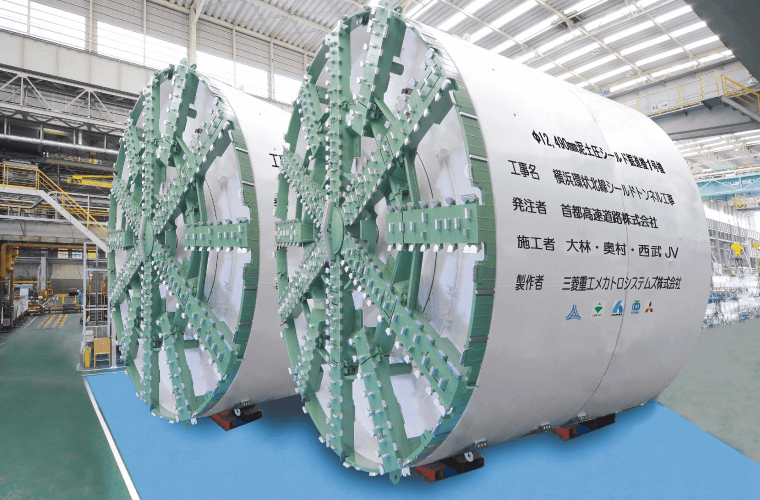
-
- DATE:
- December 2009
- PROJECT:
- Metropolitan Expressway Kanagawa Yokohama-Kita Line
- SIZE:
- φ12.49 m earth pressure balanced shield machine
- Over a distance of 8.2 km of the Yokohama-Kita Line, two shield machines were used for tunnel construction with the Koyasudai Ventilation Station from the Shin-Yokohama departure shaft. Cutting was performed on two locations of NOMST walls, which served as the earth-retaining walls of the Shin-Yokohama Ventilation Station. Long-distance excavation of 5.5 km was conducted in hard alternating strata consisting of mudstone, sandy mudstone, sand, and psammite. The structure is a diverging and merging part connected to four entrances/exits throughout the road.
-
- 2011
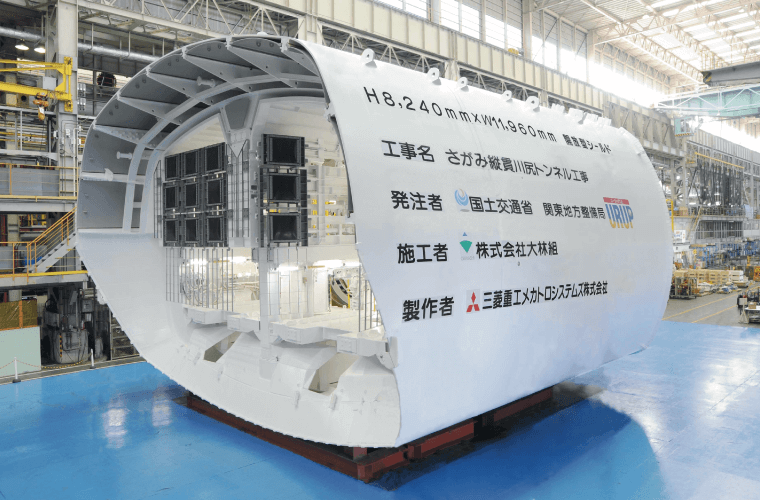
-
- DATE:
- July 2011
- TITLE:
- Open Type Shield Machine
- PROJECT:
- Construction of Sagami Traversing Lower Stream Tunnel
- SIZE:
- H8.24m×W11.96m
- This is a H: 8.24 m x W: 11.96 m open type shield machine that was used for the Sagami Traversing Lower Stream Tunnel in the Sagami Traversing Road.
In the construction zone in question, the URUP (Ultra Rapid Under Pass) method was adopted. This is a method in which the shield machine starts and stops above ground. Excavation was conducted using an excavator that was installed in the shield machine. The excavated sand was removed using a belt conveyor. Segment assembly was conducted using a self-operating erector that moves over the rails of the machine. This machine started above ground and performed excavation 413 m for the outward path and arrived above ground at the rotation base. After a U-turn, it performed excavation of the return path in the same manner as the outward path.
-
- 2011
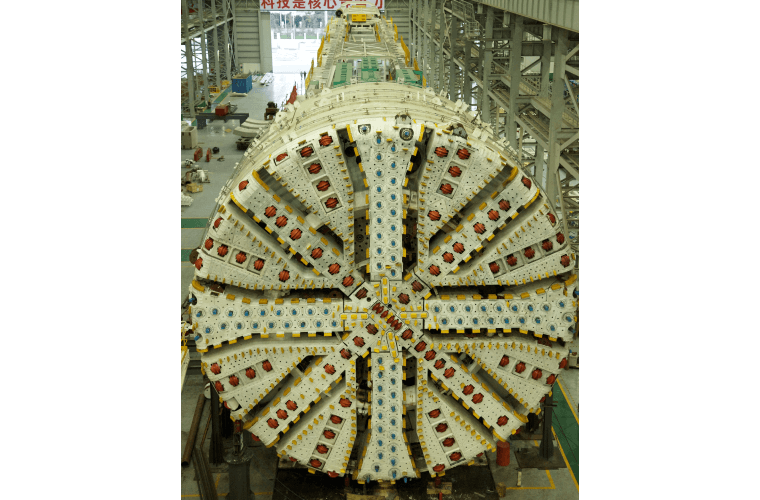
-
- DATE:
- December 2011
- TITLE:
- Handling the World’s Largest Composite Ground Under High Water Pressure
- PROJECT:
- Tunnel of China’s Nanking Weisan Road River Crossing Tunnel
- SIZE:
- φ14.93 m slurry shield machine
- These are two slurry shield machines for composite ground.They were used in the North Line and South Line that cross the Yangtze River, which flows through China’s Nanking. Air chambers were used to suppress the pressure in order to maintain the pressure of the face and prevent pressure fluctuations of this ultra-large-bore-diameter slurry shield machine under extremely high water pressure in excess of 0.7 MPa. The cutters installed for use for this composite ground were fixed and rescue type roller cutters, as well as cutter bits with spoke-internal replacement. The excavation was performed by using cutters that were approved for the soil quality in question. Also, worn cutter bits were replaced from within the spokes. As a high-speed tunnel construction project, it is possible to simultaneously perform installation of the base plates between the rear part of the machine and the following carriage. The South Line was 4,135 m, while the North Line was 3,557 m.
-
- 2012
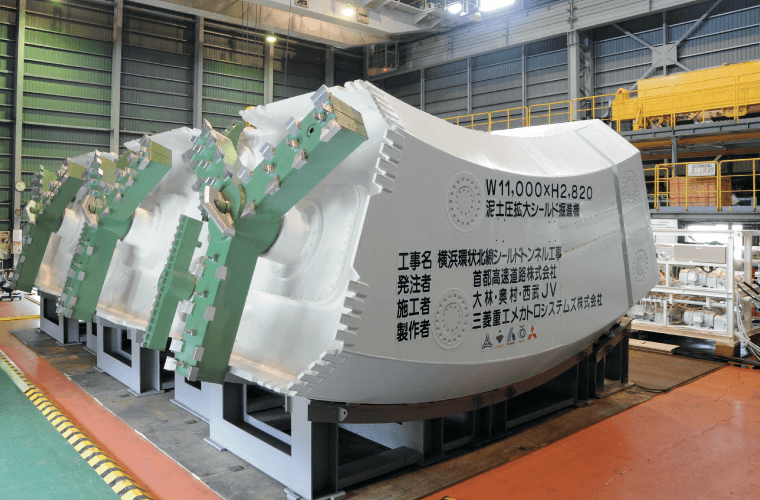
-
- DATE:
- November 2012
- TITLE:
- Concentric Circular Expansion Shield
- PROJECT:
- Metropolitan Expressway Kanagawa Yokohama-Kita Line
- SIZE:
- H: 2.82 m x W: 1.1 m Expansion Shield Machine
- This is an expansion shield machine that was used for diverging and merging parts connected to four entrances/exits throughout the Kanagawa Yokohama-Kita Line. The diverging and merging part of the zone in question was constructed by expansion digging of the ground in the impervious zone that was established through chemical grouting injection in the large-bore-diameter pipe roofs (φ1.2 m, 27 units) with multiple cases of construction performed in parallel with the main line tunnel. However, an expansion shield was used for constructing the underground space for the start and arrival of the large-bore-diameter pipe roofs. The expansion shield is used to construct an underground space for the diverging and merging part in one space through a single rotation of the circumference of the main line tunnel. Moreover, disassembly and reassembly were conducted over and over, resulting in the creation of a total of four underground spaces for diverging and merging.
-
- 2016
-
Establishment of JIM TECHNOLOGY CORPORATION
* The shield machine businesses of JTSC and were split into and inherited into a new company, JIMT